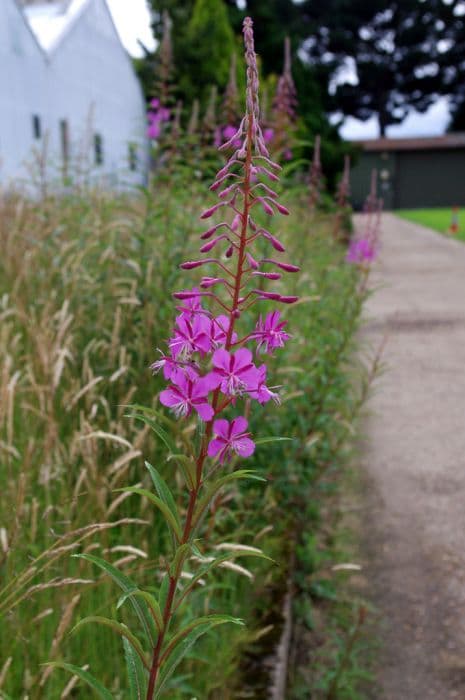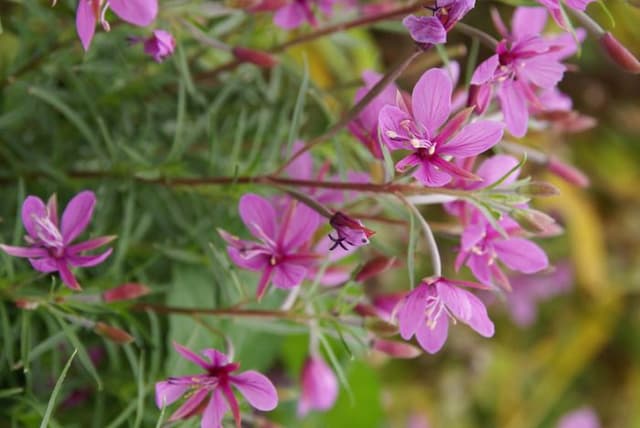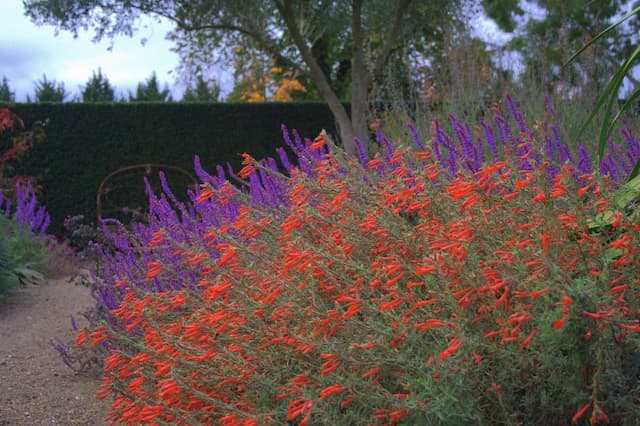Pink Gaura Oenothera lindheimeri 'Passionate Blush' (PBR) (G)

ABOUT
Passionate Blush, commonly known as Gaura, is a perennial plant that showcases a delicate and graceful appearance. It bears a profusion of lovely, blush-pink flowers that resemble small butterflies perched atop slender stems. These flowers bloom in elongated clusters, adding an airy, whimsical feel to the plant's overall look. The blossoms typically have four petals and are slightly ruffled, giving them a soft, textured effect. The foliage of Passionate Blush Gaura is also noteworthy with its lance-shaped leaves that are green, often with a hint of red or maroon, particularly along the edges or when young. The plant has a bushy habit with the stems arising from a basal clump, creating a fountain-like visual that adds movement and interest to garden settings. Its extended blooming period and charming flowers provide a long-lasting and attractive display in the garden landscape.
About this plant
 Names
NamesFamily
Onagraceae
Synonyms
Pink Gaura, Passionate Blush Wand Flower, Lindheimer's Beeblossom, Gaura
Common names
Gaura lindheimeri 'Passionate Blush'
 Toxicity
ToxicityTo humans
Gaura is not known for being toxic to humans. There are no significant reports of poisoning or serious adverse reactions upon ingesting parts of the Gaura plant. As with any plant, individual allergies or sensitivities to this plant may exist, but these would be uncommon and not widely documented. Always exercise caution and consult a healthcare professional if any unexpected symptoms arise after handling or ingesting any part of plants in general.
To pets
Gaura is not commonly recognized as a toxic plant to pets such as dogs and cats. It is not typically listed among plants that are known to cause poisoning in household pets. However, individual animals might have sensitivities or allergic reactions to plants that are generally considered non-toxic. If an animal does ingest Gaura and shows adverse symptoms, it is recommended to consult a veterinarian. Symptoms to monitor for would be similar to general plant poisoning symptoms, including vomiting, diarrhea, excessive drooling, or lethargy. However, these are unlikely to occur from ingestion of Gaura based on available information.
 Characteristics
CharacteristicsLife cycle
Perennials
Foliage type
Deciduous
Color of leaves
Green
Flower color
Pink
Height
2-3 feet [60-90 cm]
Spread
2-3 feet [60-90 cm]
Plant type
Herb
Hardiness zones
5-9
Native area
North America
Benefits
 General Benefits
General Benefits- Attractive Aesthetics: Boasts beautiful, blush pink flowers enhancing the visual appeal of gardens.
- Drought Tolerance: Once established, it is highly drought-resistant, making it ideal for xeriscaping and water-wise gardens.
- Easy Care: Low maintenance requirements, not needing frequent watering or care, making it suitable for novice gardeners.
- Long Blooming Season: Offers a long flowering period from early summer to fall, providing extended color in the landscape.
- Wildlife Attraction: Attracts pollinators such as bees, butterflies, and hummingbirds, supporting biodiversity.
- Heat Resistance: Thrives in hot climates and is tolerant of high summer temperatures.
- Deer Resistance: Generally resistant to browsing by deer, which can be advantageous in areas where deer are a problem for gardens.
- Fast Growth: It grows relatively quickly, allowing for rapid establishment and filling in of garden spaces.
- Versatility in Landscaping: Suitable for use in borders, containers, rock gardens, and as a ground cover, offering various landscaping options.
- Non-Invasive: Unlike some garden plants, it does not tend to spread uncontrollably, reducing the risk of it becoming invasive.
 Medical Properties
Medical PropertiesThis plant is not used for medical purposes.
 Air-purifying Qualities
Air-purifying QualitiesThis plant is not specifically known for air purifying qualities.
 Other Uses
Other Uses- Gaura 'Passionate Blush' can be used as a natural dye source, where different plant parts may yield unique hues for textiles and crafting materials.
- The long floral stems of Gaura 'Passionate Blush' are ideal for creating delicate, airy arrangements in floral design, adding movement and a wildflower touch.
- Gaura 'Passionate Blush' can be planted to stabilize soil and control erosion in sloped gardens due to its deep root system.
- The dried seed pods of Gaura 'Passionate Blush' can be used in potpourri mixes to add texture and visual interest to the blend.
- Gaura 'Passionate Blush' can be used as a companion plant in vegetable gardens to attract pollinators that will benefit nearby fruit and vegetable plants.
- Photographers may use Gaura 'Passionate Blush' as a soft, romantic backdrop for portrait and macro photography sessions.
- Gaura 'Passionate Blush' is sometimes used in educational settings to teach about plant lifecycles and pollination due to its attractive flowers and pollinator activity.
- The stems and foliage of Gaura 'Passionate Blush' can be used to create natural art pieces or botanical prints by pressing or casting them in different mediums.
- Gaura 'Passionate Blush' can serve as inspiration for artists and designers, who may mimic its colors and form in their works.
- In culinary presentations, the blooms of Gaura 'Passionate Blush' can be used for decorative purposes to enhance the visual appeal of dishes, although they are not edible.
Interesting Facts
 Feng Shui
Feng ShuiWhite Gaura is not used in Feng Shui practice.
 Zodiac Sign Compitability
Zodiac Sign CompitabilityWhite Gaura is not used in astrology practice.
 Plant Symbolism
Plant Symbolism- Resilience: Gaura, commonly known as Oenothera lindheimeri, often symbolizes resilience due to its ability to withstand tough environmental conditions and still produce delicate, beautiful flowers.
- Peace: The soft, blush-colored flowers can signify peace and tranquility, reflecting the serene beauty they bring to gardens and natural spaces.
- Purity: The clear, light pink petals may represent purity, an attribute commonly associated with the color white or light hues in the flower world.
- Innocence: Similar to purity, the delicate and graceful appearance of gaura blooms can convey innocence and a sense of simplicity.
- Adaptability: The gaura's ability to adapt to different soil types and climates makes it a symbol of adaptability and flexibility in various conditions.
 Water
WaterGaura, commonly known as Whirling Butterflies, should be watered deeply once a week, allowing the water to soak into the soil to promote strong root growth. During the peak of summer or in particularly hot and dry climates, you may need to water twice a week. It's essential to avoid overwatering as Gaura is drought-tolerant and too much moisture can lead to root rot. Approximately 1 gallon of water per plant each time should be sufficient. During the winter months, reduce watering frequency as the plant requires less moisture.
 Light
LightWhirling Butterflies flourish best in full sun conditions, meaning they should receive at least 6 to 8 hours of direct sunlight daily. The ideal spot for this plant is in an area where it has clear, unobstructed access to sunlight throughout the day, as this will encourage the most prolific blooming.
 Temperature
TemperatureWhirling Butterflies can tolerate a wide range of temperatures but perform best in conditions between 60°F and 90°F. They can survive briefly to temperatures as low as 10°F; however, long exposure to freezing temperatures can damage or kill the plant. During the growing season, maintaining temperatures in the ideal range will ensure the healthy growth and flowering of the Gaura.
 Pruning
PruningWhirling Butterflies benefit from pruning to remove spent flowers and encourage further blooming. Prune in early spring to remove any dead or damaged stems and to shape the plant. Additionally, a light pruning after the first flush of flowers can promote a second round of blooming. The best time for extensive pruning is late winter or early spring before new growth begins.
 Cleaning
CleaningAs needed
 Soil
SoilGaura, commonly known as Whirling Butterflies, thrives in well-draining soil with added compost or other organic matter. The best soil mix should include two parts garden soil, one part perlite or coarse sand, and one part compost to ensure good aeration and nutrient content. Gaura prefers a soil pH between 5.5 to 7.0. Ensure that the soil is not too wet, as Gaura does not like soggy conditions.
 Repotting
RepottingGaura, also known as Whirling Butterflies, generally doesn't require frequent repotting and can be left undisturbed for several years. Repotting every 3-4 years in spring is sufficient unless the plant has outgrown its container or the soil has become compacted. When repotting, choose a slightly larger pot to give the roots room to expand and refresh the soil mix to replenish nutrients.
 Humidity & Misting
Humidity & MistingWhirling Butterflies, the common name for Gaura, is tolerant to a range of humidity levels and does not have specific humidity requirements. It can thrive in the average humidity found in most outdoor environments. As a native to Texas and Louisiana, it is well-adapted to relatively dry conditions and doesn't need the high humidity that some other plants prefer.
 Suitable locations
Suitable locationsIndoor
Place Whirling Butterflies in bright, indirect light.
Outdoor
Plant Whirling Butterflies in full sun, well-draining soil.
Hardiness zone
5-9 USDA
 Life cycle
Life cycleOenothera lindheimeri 'Passionate Blush', commonly known as Gaura or Pink Gaura, begins its life cycle as a seed, sown in warm soil after the threat of frost has passed or started indoors before the last frost date. Once germinated, the seedling grows into a rosette of foliage close to the ground before sending up tall, flowering stems. The flowering stage occurs in late spring to summer when the plant produces airy spikes of pink blooms that attract bees and butterflies. After pollination, the plant sets seed, which matures by late summer to fall, at which point the plant often dies back, however, Gaura is a perennial and will regrow from its base in subsequent seasons in appropriate climates. During winter or in harsher climates, the top growth may die back completely, but with proper care, the root system remains alive and the plant will regenerate in the spring. Over several years, the Gaura clump can become quite large and may need division to maintain vigor and flower production.
 Propogation
PropogationPropogation time
Spring to Summer
Oenothera lindheimeri 'Passionate Blush', commonly known as Gaura, is best propagated by cuttings. The optimal time for taking cuttings is late spring or early summer when the plant is in active growth. To propagate Gaura from cuttings, a gardener should select a healthy stem with new growth and cut a 4 to 6 inch (10 to 15 cm) section just below a leaf node. The lower leaves are then removed, and the cut end can be dipped in rooting hormone to encourage root development. The cutting should be placed in well-draining soil or a potting mix and kept moist until roots are established, after which it can be transplanted to a desired location in the garden. This method is favored for its efficiency and the likelihood of producing true-to-type plants that retain the characteristics of 'Passionate Blush'.









